EXPLORING THE COAST FROM BORDEAUX TO LA ROCHELLE
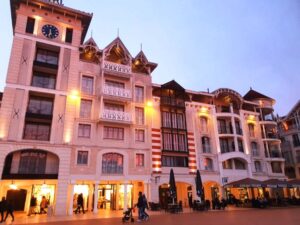
Our initial idea was to make our way straight from Bordeaux up the coast, and although we had intended to stop off briefly along the way at various points of interest, our main aim was simply to get to La Rochelle. We had been to La Rochelle some years ago, and remembered it as being a very attractive port town with lots to see and do. However, we hadn’t realised just how much there is to see en route, and so what was supposed to be a less than two hr. car trip, with some quick diversions on the way, instead turned out to take several days!

Before we headed northwards from Bordeaux, we took a detour 60 kms south-west to the coastal town of Arcachon. You can also take a direct train across from Bordeaux, which only takes around 54 mins., making it a very viable day trip. Some people combine Arcachon with a visit to the Dune du Pilat, the tallest sand dune in Europe, and one of the most popular destinations in the country.
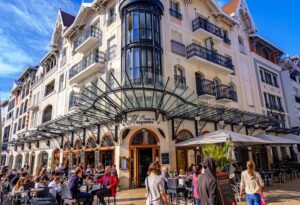
Arcachon is known for its long sandy beaches located on the south part of a wide bay, but also most particularly for its oyster harvesting, that are reputed to be the most succulent of any along the Atlantic coast.
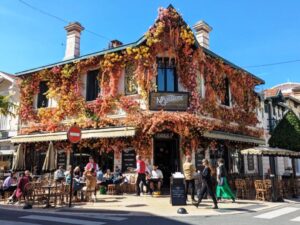
The town is divided into 4 sectors. The Ville d’Été (summer city) is the city centre, with elegant buildings, pedestrianised streets, restaurants, and the main beach, regarded as one of the safest for kids on the Atlantic coast.
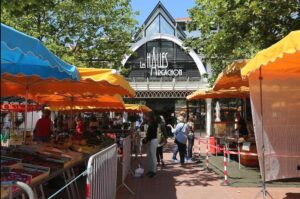
Even just to stroll along the beautiful promenade next to the main beach is a delight. One of the main attractions in Arcachon’s city centre is the main market, Marché d’Arcachon, but also don’t miss the terrific covered market, full of food stands brimming with local delicacies.
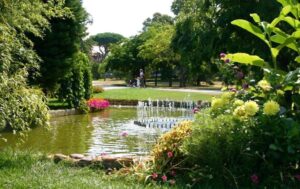
Overlooking La Ville d’Été is the delightful Parc Mauresque, built in 1843—you can spot it right from the city centre. If you don’t fancy climbing too many stairs, there’s a lift that will take you all the way up to the park’s centre. Next to the park is the Observatoire de Sainte Cecile, an iron framed platform, or belvedere, from where you will enjoy an incredible panoramic view of Arcachon Bay. If it reminds you of the Eiffel Tower, that’s because Gustave Eiffel was part of the project team.
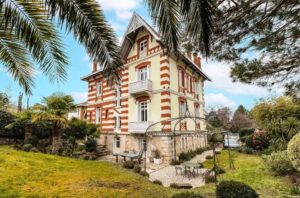
The Ville d’Hiver (winter city) is the most beautiful part of Arcachon. Built on the hills of the city in the late 19th century, it’s adorned with more than 300 stunning 19th century villas and attracts many visitors, thanks to the gorgeous architecture.
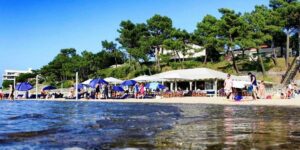
The Ville d’Automne (autumn city) is the port and the fishing area of Arcachon. Lastly, the Ville de Printemps (spring city) covers the most beautiful beaches in the southern part of the bay. It’s said that the best beaches of Arcachon are located in this part of the city, one of which, Plage Pereire, starts right after the pedestrian promenade.
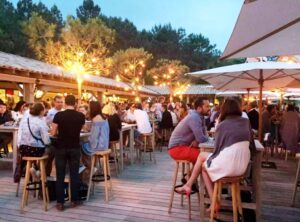
It’s a beautiful 3 km long beach with white sand and equipped with many sports facilities, a cycle path and green lawns perfect for picnicking, and in the summer months, the beach café, Club Plage Pereire, is just the spot for a very pleasant meal or a just a drink on the beach.
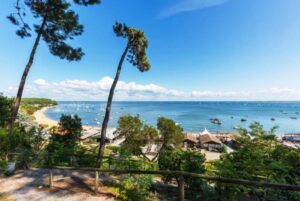
From here, there’s a view of the Cap Ferret peninsula on the other side of the bay. This is one of the most charming villages on the Bassin d’Arcachon, and known particularly for its oyster farming—there are a number of restaurants on the beach that are reputed to serve the freshest in the area.
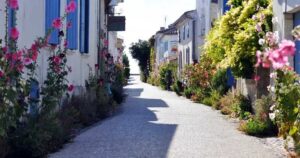
We thought we’d simply resume our original plan to head north from Bordeaux, but rather than taking the more direct inland road, we took the coast road. An hour and half northwards on this road leads to Talmont-sur-Gironde, designated as one of the ‘Plus Beaux Villages de France’ as well as one of the ‘Petites Cités de Caractère’. Discover a village founded in 1284 by Edward 1st of Aquitaine, on a rocky promontory overlooking the Gironde Estuary.
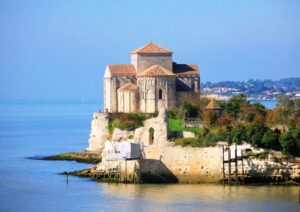
Dominating the village, and still fortified with ramparts, is the magnificent church of Sainte-Radegonde, a symbol of the Poitou-Charentes region. In the village, pretty houses with white facades and blue shutters, artisan studios, flowering plants lining cobbled streets, and stunning views await. Well worth a quick detour.
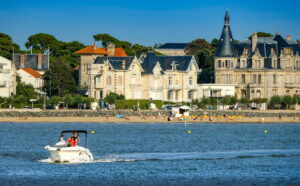
Barely 20 minutes further north of Talmont-sur-Gironde is Royan, a resort town on the coast and at the mouth of the Gironde estuary. Known for its fine sandy beaches and sheltered waters, the town itself was heavily bombed by the Allies in September 1944 and again in April 1945.
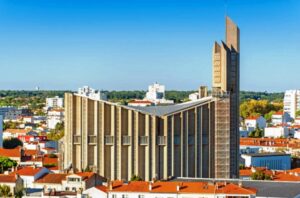
It became known as “the martyred city”, and was declared a “Laboratory”, becoming a showcase of research on urbanism and the Modernist architecture of the 1950s, one example being a rather startling modern concrete church, Nôtre-Dame de Royan.
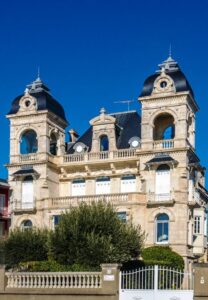
It was classified as a Ville d’Art et d’Histoire in 2010. However, the town still has around 30 or so impressive villas from the Belle Époque era, built at a time when sea bathing became fashionable. It also attracted many well-known artists during the Roaring Twenties. The town has a marina for over 1,000 boats and an active fishing port. The impressive Cordouan Lighthouse stands on an islet in the estuary, and is accessible by ferry, if you’d like to visit.
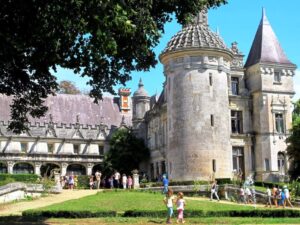
Back on the main road, slightly inland from the coast, keep an eye out for the Château d’Usson, recently renamed Château des Enigmes, in line with the theme of a treasure hunt the owners have created for children. This is a beautiful Renaissance style château with gardens, an orangery and a little farm. You can visit the château’s interiors, and discover its underground passages. For those interested in one of the district’s most famous products, the Château is only 30 mins. from Cognac.
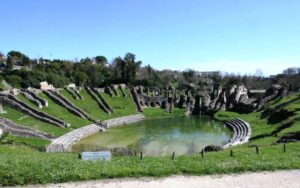
About 30 kms further along, primarily on the left bank of the Charente, is the town of Saintes —originally called Mediolanum Santonum–that has a Roman amphitheatre whose construction started during the reign of the Emperor Tiberius, (14 – 37CE) and completed until the Emperor Claudius. The Amphitheatre of Mediolanum was one of the earliest in Gaul, and constructed when the city became the capital of Greater Aquitaine. Built outside the walls, the amphitheatre could seat 15,000 spectators and was known for gladiatorial contests and animal hunts.
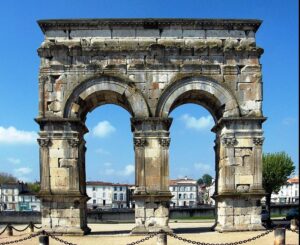
The town also had other important Roman-era monuments such as the Arch of Germanicus, the thermal baths, and an aqueduct which is still partially visible today. Due to its important Gallo-Roman, medieval and classical heritage, Saintes has been a member of the French Towns and Lands of Art and History since 1990, and has several museums and organises numerous festivals. It is also a European centre of musical research and practice in the local Abbaye aux Dames.
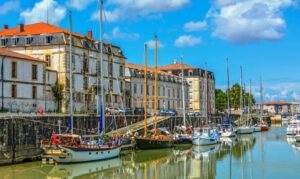
From Saintes, heading towards La Rochelle, just a couple of minutes off the main road you’ll come to Rochefort, one of the most beautiful Small Towns of Character. A port on the Charente estuary, and without doubt, a visit is like stepping back in time. Originally, it was an area of swamps and marshes, but today, what we see is an incredible heritage site with museums, mills and traces of historic shipbuilding activity.
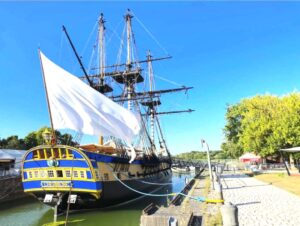
One of Rochefort’s great attractions is the Arsenal Quarter. Created in the 1660s, as Louis XIV’s Royal Dockyards, to be the “largest and most beautiful arsenal in the kingdom”, it operated for over 3 centuries. 550 ships were built, rigged and launched from the docks. A replica of the ‘Hermione’, the legendary frigate that carried the Marquis de La Fayette to America was built here, is on show. This replica, built back in 1997, was a mammoth undertaking, and took 17 years to complete. Following its namesake, it undertook an historic voyage to America. She’s now docked in Rochefort and visitors can go abord to admire the incredible workmanship, which brought a 17th century ship to life in the 21st century.
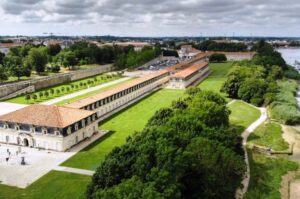
The centrepiece of Louis XIV’s dockyards was the rope-making factory, the Corderie Royale. It was absolutely critical for the production of rigging for warships. As some sails were very tall, ropes had to be long enough to fulfil the need. At 374m long, the rope factory is still a very impressive sight today. It’s now a fascinating museum, with excellent explanations about the cultivation of hemp, and shows how the plant’s fibres were twisted into 200m lengths of rigging for 200 ships, up to the introduction of steel cables. You can also have a go at making a rope yourself!
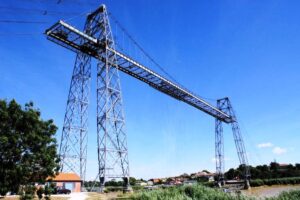
One sight not to be missed nearby is the Pont Transbordeur du Martrou (Rochefort-Martrou Transporter Bridge). This is the only surviving bridge of its kind in France, built in 1900, and now listed as an historic monument, it’s an incredible heritage site. To this day, it carries foot passengers and cyclists across the river Charente on a platform suspended on cables attached to a metal framework over the river. There’s an interpretation centre, the Maison du Transbordeur, where you can discover all about the history of the bridge.
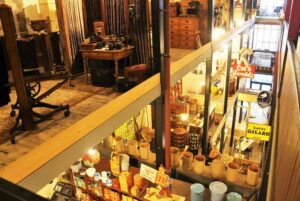
Another really interesting museum is the Musée des Commerces d’Autrefois—which roughly translates as a museum of trades of yesteryear. There are 22 galleries which recreate the ateliers (workshops) and shop floors of trades of the past. For example, you can step into an old bicycle repair shop, a milliner’s atelier, and a cognac distillery. There are lovely vintage posters, and original artefacts of everyday appliances from between 1900 and WW2. Even the in-house bistro is fun.
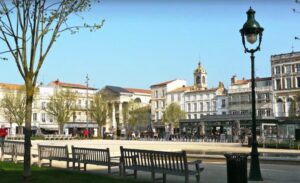
Rochefort was built as a 17th century version of a “new town” by Louis XIV’s minister, Colbert, and designed with grand avenues, elegant 17th century houses and plenty of charm. In the centre of town, Place Colbert is a great place to take a break for a coffee and a spot of people-watching. Nearby rue Courbet is little changed from the 17th century with its cobblestones brought from Canada as ships’ ballast. Most of the houses in this part of town are the original 17th-19th century properties. The houses are typically built from the local white stone and often have decorative entrances or balconies. An interesting titbit of trivia: the layout of the town was designed by a certain Monsieur Bégon, who also gave his name to the Begonia flower.
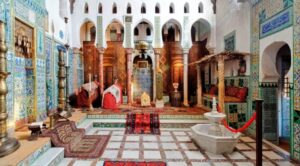
The former home of the French novelist Julian Viaud, who wrote under the pen name of Pierre Loti, is open as a house museum. A naval officer, he wrote numerous best-selling romances set in exotic Oriental locations. From outside, the house looks fairly unprepossessing, but inside, it’s much more interesting, with a medieval-themed banqueting hall, complete with a Gothic fireplace, Gobelins tapestries, and an Arab room, among other treasures.
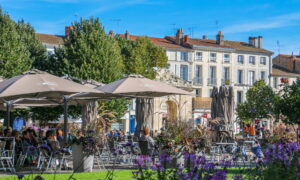
Somewhat reluctant to leave delightful Rochefort, we continued on our way for a further 40kms up the coast road to La Rochelle after enjoying some great diversions along the way. I’ll share our La Rochelle experiences in the next blog story.
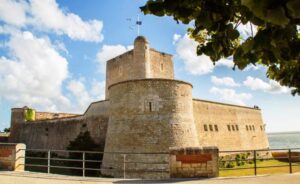


Thank you ! It definitely looks worth visiting.
Every town in France has such charm !
Hi Julie,
I think you would find La Rochelle a very rewarding place to explore. It has its own character, which is understandable given its history, and aside from that, it is such an attractive place. Cheers, Cheryl
Thanks , Cheryl. I have been to La Rochelle twice . Lovely white buildings glistening in the sun. My friend Alexandrine , lives there .
I have also been to Bordeaux . Not a place I liked . Flat, hot and dirty and Garonne river was filthy.But I did do half day trip from Bordeaux to St Emilion, which I loved. I’ve not been to see the great dune at Arcachon. It’s on my bucket list .
Another question.. how do you manage your trips taking into account the Schengen Rule ?
Cheers, Lois
Hi Lois,
La Rochelle is a gem, isn’t it? Bordeaux improves with each subsequent visit I think. The first time we went there, years ago, it was exactly as you say: grimy buildings, unloved public spaces–not a place to hang out for any time, and so much in the general area that had more appeal such as St Emilion. However, this time around, we found the city spruced up considerably and the tram system that covers so much of the city and outskirts, is terrific. Perhaps worth another look one day? Ref. your enquiry about the Schengen issue: we are very careful that our total visits within that zone each year don’t go over the max. One of the few good things about the UK no longer being in Europe, is that a visit there doesn’t count–although it’s not in the Schengen zone. It does take careful management though! Cheers, Cheryl
Thanks again Cheryl . Cheers, Lois